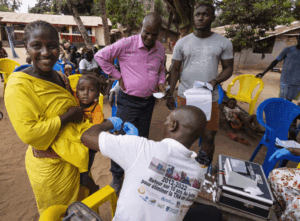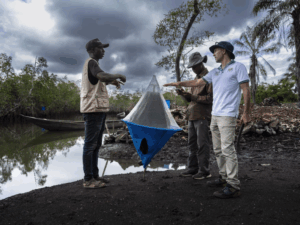Going From Door to Door
A story by the Drugs for Neglected Diseases initiative (DNDi)
Photos by Brent Stirton/Getty Images for DNDi
(Read the Introduction to this series here, Step 1: Controlling the TseTse Fly here, Step 2: Building Trust here.)

The small village of Douprou sits by one of the many rivers that drain the mangroves near the town of Boffa. Along with Dubreka and Forécariah, Boffa is one of the three main areas affected by sleeping sickness in Guinea.
Today, a Sleeping Sickness Programme team – responsible for prospection médicale, or a mass screening – is in Douprou to test the entire village. Although it is only a short drive from the main road linking up Guinea’s major coastal towns, Douprou is relatively remote, accessible only by a dirt road that can be treacherous to travel during Guinea’s rainy season.
In a scene that is repeated throughout sleeping sickness-endemic regions of West and Central Africa, a ‘mobile’ screening team sets up under the shade of a tree in the middle of the village, with the entire town called out to this field laboratory to carry out a set of tests for sleeping sickness. This scene – in many ways the hallmark image of the fight against sleeping sickness – was invented by a French military physician, Colonel Eugène Jamot, in the early part of the 20th century in the European colonies.
Today’s screening was organized in Douprou because a case was detected here back in 2023, so the team has come back to see if there are any more. On average, there are about two screenings a year.
To start, the screening team records all the names of the villagers who are asked to line up at the camp. Everyone has a blood sample taken from the fingertip. The analysis is done on the spot – in a ‘field lab’, a collection of old wooden tables with lab equipment set on top. If the fingertip blood is positive, the person is asked to stay a little longer while a second sample of blood is taken from a vein for deeper examination and questions are asked about any possible symptoms.


On site, the veinous blood is put in a centrifuge and diluted in order to perform a parasitology exam. Patients that are positive to this second test are then referred for treatment. Countless lives have been saved this way in sleeping sickness-endemic countries, thanks as well to new rapid diagnostic tests that give results in 15 minutes and allow onsite detection of sleeping sickness.
‘Around 2012-2013, we had more than 50 cases in this area,’ said Oumou Camara, the Diagnostic Manager at the National Programme for Neglected Tropical Diseases, Guinea. ‘Now we are looking for the last cases. In 2024 we didn’t record any more cases in Boffa. We are really on track to eliminating this disease.’
Once the mobile team leaves, entomologists from the sleeping sickness programme will come and set up tiny traps around the village – following the daily path of the patient to ensure that the flies that live in the areas where they likely caught the disease cannot transmit it to others.

Research collaborations
At the heart of Guinea’s sprawling capital, Conakry, a state-of-the-art research centre is leading on another research collaboration that is shining important light on testing for sleeping sickness in Guinea, and across the Continent.
The ultra-modern Pasteur Laboratory has its campus at the Gamal Abdel Nasser University of Conakry. The laboratory is part of the Institut Pasteur de Guinée (IPG), which was founded in the wake of the Ebola epidemic in 2015. Part of the venerable French not-for-profit Institut Pasteur Network, the IPG has been a key partner of the Guinea Sleeping Sickness National Programme.
The Institut Pasteur has been leading important studies around asymptomatic patients, or patients that have sleeping sickness but do not display any symptoms. The ‘Trypskin’ project, led by the Institut Pasteur along with DNDi and the IRD, is testing skin samples to see if sleeping sickness parasites persist in the skin and are being ‘missed’ by blood tests, especially for asymptomatic patients.


‘We realized that certain people did not have parasites in the blood, so weren’t treated,’ said Dr Bucheton. ‘This study should help us to better identify people with the infection, which will have a very significant impact on transmission and eventually reaching zero cases of sleeping sickness,’ he said.

Coming soon! Step 4: Innovation to go the last mile
Related Articles

Bölët Mouna: Inside Guinea’s Quest to Eliminate Sleeping Sickness (Step 4)
Guinea has achieved a historic milestone by eliminating sleeping sickness as a public health problem, becoming the first country to conquer this deadly neglected tropical disease with the support of DNDi. In Step 4, read about going the last mile.

Bölët Mouna: Inside Guinea’s Quest to Eliminate Sleeping Sickness (Step 2)
Guinea has achieved a historic milestone by eliminating sleeping sickness as a public health problem, becoming the first country to conquer this deadly neglected tropical disease with the support of DNDi. In Step 2, read how community trust was built.

Bölët Mouna: Inside Guinea’s Quest to Eliminate Sleeping Sickness (Step 1)
Guinea has achieved a historic milestone by eliminating sleeping sickness as a public health problem, becoming the first country to conquer this deadly neglected tropical disease with the support of DNDi. In Step 1, read how the tsetse fly was controlled.
